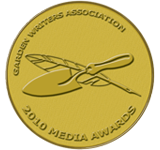Celebrating The Year of the Allium
April 23, 2016 by Robin Plaskoff Horton
As 2016 is the Year of the Allium, it seemed like a good opportunity to pay tribute to this lovely genus of flowering plants. Appearing often amid the naturalistic planting schemes for which the Dutch landscape designer and father of the New Perennial Movement, Piet Oudolf is known, alliums blend well with low maintenance “prairie garden” ornamental grasses and perennials like salvia sedum, rudbeckia, and echinacea.
 Lurie Garden, Chicago. Photo: Robin Plaskoff Horton, Urban Gardens.
Lurie Garden, Chicago. Photo: Robin Plaskoff Horton, Urban Gardens.
 Spot the alliums? Lurie Garden, Chicago. Photo: Robin Plaskoff Horton, Urban Gardens.
Spot the alliums? Lurie Garden, Chicago. Photo: Robin Plaskoff Horton, Urban Gardens.
A Love-Hate Relationship
Residential gardeners benefit from planting alliums as plant devouring deer hate them. The beautiful blooms are odorless until crushed, when they release strong sulfur-based chemicals emitting a volatile odor and bitter taste.
Alliums repel deer, but the flowers contain a sweet nectar that bees and other pollinators love.
Of the eight hundred species, just a few in allium family are edibles: leeks, shallots, garlic, and chives are common ingredients in almost every culture’s gastronomy.
Edible Relatives: History and Myths
To provide delicious repasts in their afterlives, the Pharaohs in ancient Egypt were entombed with garlic and onions while the pyramid building slaves consumed a daily ration of garlic for strength and endurance and to ward of illness. Known for its healing powers, garlic was believed to offer protection against the plague as well as supernatural evils and demonic forces like vampires, witches and sorcerers.
Alliums In the Windy City
Oudolf included alliums in his planting plan for the High Line in New York and they also feature prominently in his matrix garden scheme for Chicago’s Lurie Garden–apropos because the city of Chicago gets its name from an edible allium, the onion.
 Lurie Garden, Chicago. Photo: Robin Plaskoff Horton, Urban Gardens.
Lurie Garden, Chicago. Photo: Robin Plaskoff Horton, Urban Gardens.
Many historians believe that the Windy City’s name comes from the Native American Miami-Illinois word shikaakwa aka smelly onion. Plant-based naming systems were common with Native Americans as a method of remembering which plants grew where, helpful for gathering food. In her book, Onions and Garlic: A Global History, author Martha Jay offers some cool factoids about edible alliums and in Eric Block’s Garlic and Other Alliums: Lore and Science, you’ll find examples of alliums in art, literature, agriculture, and medicine with illustrations including some rare botanical drawings.
 Alliums at Getty Center Garden. Photo: Robin Plaskoff Horton, Urban Gardens.
Alliums at Getty Center Garden. Photo: Robin Plaskoff Horton, Urban Gardens.
The Getty Center Gardens
The Getty Center Gardens’ designer, the contemporary artist Robert Irwin, once remarked, “Art shows you the world in ways you haven’t seen it before; it brings you back to look at it again.” These words resonated for me recently, during my second visit to the 134,000-square-foot central garden, perched on a hilltop in the Santa Monica Mountains overlooking the west side of Los Angeles. When I first visited the Getty in 1997 soon after it opened, the garden had not yet been filled with the over 500 plant varieties it contains today.
 Allium at Getty Center Garden. Photo: Robin Plaskoff Horton, Urban Gardens.
Allium at Getty Center Garden. Photo: Robin Plaskoff Horton, Urban Gardens.
This time around, with the garden was nearly in full bloom, I spotted some spectacular and varied ornamental alliums. The Purple Sensation alliums were standouts; with vibrant round blooms atop their tall stalks, these alliums appear like bursts of fireworks as they rise above neighboring plants.
 Getty Center Garden. Photo: Robin Plaskoff Horton, Urban Gardens.
Getty Center Garden. Photo: Robin Plaskoff Horton, Urban Gardens.
Looking out from the gardens and the travertine-clad museum complex, you can catch a glimpse of the Pacific Ocean in the distance, peaks of the San Gabriel Mountains, and the City of Angel’s traffic congested grid of streets. In his design for the Getty Center, architect Richard Meir drew inspiration from the relationship between the site’s surrounding elements, while highlighting and marrying nature and culture from inside and out.
Looking for some inspiration? Check out APLD landscape designer, Nick McCullough’s beautiful designs with alliums on his blog Thinking Outside the Boxwood.
In celebration of the Year of the Allium, Longfield Gardens is offering a $50 gift certificate toward the purchase of Allium bulbs. The winner will be picked at random. (Available only to readers in the United States excluding Alaska, Hawaii, and Puerto Rico.)
[contestfriend contest=”24845″]
Want more? Check out these garden designer’s blogs for their take on the beautiful allium:
Slow Flowers Founder Debra Prinzing’s in awe with alliums….
Jason Kay’s GardenInaCity
Angie Rose’s The Freckled Rose
Unless otherwise noted, photos via Longfield Gardens.










 e-mail a friend
e-mail a friend


















A Beginner's Guide To Alliums | Angie The Freckled Rose Pingback said:
[…] Horton of Urban Gardens invites us to read about the history of alliums and shares some helpful facts. She also […]
— April 26, 2016 @ 11:35